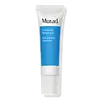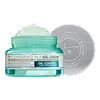What's inside
What's inside
 Key Ingredients
Key Ingredients

 Benefits
Benefits

 Concerns
Concerns

 Ingredients Side-by-side
Ingredients Side-by-side

Water
Skin ConditioningHamamelis Virginiana Water
AstringentGlycerin
HumectantPentylene Glycol
Skin ConditioningHydroxyethyl Urea
HumectantHydroxyethyl Acrylate/Sodium Acryloyldimethyl Taurate Copolymer
Emulsion StabilisingDimethicone
EmollientPolymethylsilsesquioxane
Tapioca Starch
Diisopropyl Sebacate
EmollientSalicylic Acid
MaskingUrea
BufferingYeast Amino Acids
HumectantTrehalose
HumectantInositol
HumectantTaurine
BufferingBetaine
HumectantZingiber Officinale Root Extract
MaskingBisabolol
MaskingSodium Hyaluronate
HumectantMelia Azadirachta Leaf Extract
Skin ConditioningMelia Azadirachta Flower Extract
Skin ConditioningCorallina Officinalis Extract
Skin ConditioningCoccinia Indica Fruit Extract
Skin ConditioningSolanum Melongena Fruit Extract
Skin ConditioningAloe Barbadensis Flower Extract
EmollientCurcuma Longa Root Extract
MaskingOcimum Sanctum Leaf Extract
Skin ConditioningOcimum Basilicum Flower/Leaf Extract
TonicLysolecithin
EmulsifyingSclerotium Gum
Emulsion StabilisingPolyisobutene
Polysilicone-11
Polydextrose
HumectantDextrin
AbsorbentEthylhexyl Hydroxystearate
EmollientPullulan
Xanthan Gum
EmulsifyingAmylopectin
Niacinamide
SmoothingSerine
MaskingButylene Glycol
HumectantPEG-7 Trimethylolpropane Coconut Ether
EmulsifyingSorbitan Isostearate
EmulsifyingPolysorbate 60
EmulsifyingGlyceryl Polyacrylate
Algin
MaskingDisodium Phosphate
BufferingSilica
AbrasiveDipropylene Glycol
HumectantPinus Densiflora Leaf Extract
AntimicrobialDecyl Glucoside
CleansingPotassium Phosphate
BufferingLactobacillus Ferment
Skin ConditioningLeuconostoc/Radish Root Ferment Filtrate
AntimicrobialCaprylyl Glycol
EmollientHexylene Glycol
EmulsifyingDisodium EDTA
Hydroxypropyl Cyclodextrin
MaskingCitric Acid
BufferingPhenoxyethanol
PreservativeBenzoic Acid
MaskingLimonene
PerfumingHydroxycitronellal
PerfumingParfum
MaskingWater, Hamamelis Virginiana Water, Glycerin, Pentylene Glycol, Hydroxyethyl Urea, Hydroxyethyl Acrylate/Sodium Acryloyldimethyl Taurate Copolymer, Dimethicone, Polymethylsilsesquioxane, Tapioca Starch, Diisopropyl Sebacate, Salicylic Acid, Urea, Yeast Amino Acids, Trehalose, Inositol, Taurine, Betaine, Zingiber Officinale Root Extract, Bisabolol, Sodium Hyaluronate, Melia Azadirachta Leaf Extract, Melia Azadirachta Flower Extract, Corallina Officinalis Extract, Coccinia Indica Fruit Extract, Solanum Melongena Fruit Extract, Aloe Barbadensis Flower Extract, Curcuma Longa Root Extract, Ocimum Sanctum Leaf Extract, Ocimum Basilicum Flower/Leaf Extract, Lysolecithin, Sclerotium Gum, Polyisobutene, Polysilicone-11, Polydextrose, Dextrin, Ethylhexyl Hydroxystearate, Pullulan, Xanthan Gum, Amylopectin, Niacinamide, Serine, Butylene Glycol, PEG-7 Trimethylolpropane Coconut Ether, Sorbitan Isostearate, Polysorbate 60, Glyceryl Polyacrylate, Algin, Disodium Phosphate, Silica, Dipropylene Glycol, Pinus Densiflora Leaf Extract, Decyl Glucoside, Potassium Phosphate, Lactobacillus Ferment, Leuconostoc/Radish Root Ferment Filtrate, Caprylyl Glycol, Hexylene Glycol, Disodium EDTA, Hydroxypropyl Cyclodextrin, Citric Acid, Phenoxyethanol, Benzoic Acid, Limonene, Hydroxycitronellal, Parfum
Water
Skin ConditioningGlycerin
HumectantButylene Glycol
HumectantNiacinamide
SmoothingDimethicone
EmollientAlcohol Denat.
AntimicrobialBetaine
HumectantCoco-Caprylate/Caprate
EmollientSqualane
EmollientAmmonium Acryloyldimethyltaurate/Vp Copolymer
Hydroxyethylpiperazine Ethane Sulfonic Acid
BufferingAloe Barbadensis Leaf Juice Powder
Skin ConditioningSarcosine
Skin ConditioningAdenosine
Skin ConditioningGluconolactone
Skin ConditioningMenthoxypropanediol
MaskingMethyldihydrojasmonate
MaskingPalmitoyl Tetrapeptide-7
Skin ConditioningPalmitoyl Tripeptide-1
Skin ConditioningSodium Hydroxide
BufferingTetrasodium Glutamate Diacetate
Zinc PCA
HumectantHydrogenated Lecithin
EmulsifyingSilica Silylate
EmollientAcrylates/C10-30 Alkyl Acrylate Crosspolymer
Emulsion StabilisingAluminum Starch Octenylsuccinate
AbsorbentCarbomer
Emulsion StabilisingCetearyl Alcohol
EmollientCetearyl Glucoside
EmulsifyingPolysorbate 20
EmulsifyingSodium Lactate
BufferingStearyl Dimethicone
EmollientLimonene
PerfumingLinalool
PerfumingCI 42090
Cosmetic ColorantChlorphenesin
AntimicrobialPhenoxyethanol
PreservativeParfum
MaskingWater, Glycerin, Butylene Glycol, Niacinamide, Dimethicone, Alcohol Denat., Betaine, Coco-Caprylate/Caprate, Squalane, Ammonium Acryloyldimethyltaurate/Vp Copolymer, Hydroxyethylpiperazine Ethane Sulfonic Acid, Aloe Barbadensis Leaf Juice Powder, Sarcosine, Adenosine, Gluconolactone, Menthoxypropanediol, Methyldihydrojasmonate, Palmitoyl Tetrapeptide-7, Palmitoyl Tripeptide-1, Sodium Hydroxide, Tetrasodium Glutamate Diacetate, Zinc PCA, Hydrogenated Lecithin, Silica Silylate, Acrylates/C10-30 Alkyl Acrylate Crosspolymer, Aluminum Starch Octenylsuccinate, Carbomer, Cetearyl Alcohol, Cetearyl Glucoside, Polysorbate 20, Sodium Lactate, Stearyl Dimethicone, Limonene, Linalool, CI 42090, Chlorphenesin, Phenoxyethanol, Parfum
Ingredients Explained
These ingredients are found in both products.
Ingredients higher up in an ingredient list are typically present in a larger amount.
Betaine is a common humectant (a substance that promotes retention of moisture). It's known to be gentle on the skin and can help balance hydration.
This ingredient is best for improving hydration and soothing irritated skin. Studies also show it helps even out skin tone.
Fun fact: Betaine is naturally created in the skin and body. The kind found within cosmetic products can be either plant-derived or synthetic.
Another name for betaine is trimethylglycine.
Learn more about BetaineButylene Glycol (or BG) is used within cosmetic products for a few different reasons:
Overall, Butylene Glycol is a safe and well-rounded ingredient that works well with other ingredients.
Though this ingredient works well with most skin types, some people with sensitive skin may experience a reaction such as allergic rashes, closed comedones, or itchiness.
Learn more about Butylene GlycolDimethicone is a type of synthetic silicone created from natural materials such as quartz.
What it does:
Dimethicone comes in different viscosities:
Depending on the viscosity, dimethicone has different properties.
Ingredients lists don't always show which type is used, so we recommend reaching out to the brand if you have questions about the viscosity.
This ingredient is unlikely to cause irritation because it does not get absorbed into skin. However, people with silicone allergies should be careful about using this ingredient.
Note: Dimethicone may contribute to pilling. This is because it is not oil or water soluble, so pilling may occur when layered with products. When mixed with heavy oils in a formula, the outcome is also quite greasy.
Learn more about DimethiconeGlycerin is already naturally found in your skin. It helps moisturize and protect your skin.
A study from 2016 found glycerin to be more effective as a humectant than AHAs and hyaluronic acid.
As a humectant, it helps the skin stay hydrated by pulling moisture to your skin. The low molecular weight of glycerin allows it to pull moisture into the deeper layers of your skin.
Hydrated skin improves your skin barrier; Your skin barrier helps protect against irritants and bacteria.
Glycerin has also been found to have antimicrobial and antiviral properties. Due to these properties, glycerin is often used in wound and burn treatments.
In cosmetics, glycerin is usually derived from plants such as soybean or palm. However, it can also be sourced from animals, such as tallow or animal fat.
This ingredient is organic, colorless, odorless, and non-toxic.
Glycerin is the name for this ingredient in American English. British English uses Glycerol/Glycerine.
Learn more about GlycerinLimonene is a fragrance that adds scent and taste to a formulation.
It's found in the peel oil of citrus fruits and other plants such as lavender and eucalyptus. The scent of limonene is generally described as "sweet citrus".
Limonene acts as an antioxidant, meaning it helps neutralize free radicals.
When exposed to air, oxidized limonene may sensitize the skin. Because of this, limonene is often avoided by people with sensitive skin.
The term 'fragrance' is not regulated in many countries. In many cases, it is up to the brand to define this term. For instance, many brands choose to label themselves as "fragrance-free" because they are not using synthetic fragrances. However, their products may still contain ingredients such as essential oils that are considered a fragrance.
Learn more about LimoneneNiacinamide is a multitasking form of vitamin B3 that strengthens the skin barrier, reduces pores and dark spots, regulates oil, and improves signs of aging.
And the best part? It's gentle and well-tolerated by most skin types, including sensitive and reactive skin.
You might have heard of "niacin flush", or the reddening of skin that causes itchiness. Niacinamide has not been found to cause this.
In very rare cases, some individuals may not be able to tolerate niacinamide at all or experience an allergic reaction to it.
If you are experiencing flaking, irritation, and dryness with this ingredient, be sure to double check all your products as this ingredient can be found in all categories of skincare.
When incorporating niacinamide into your routine, look out for concentration amounts. Typically, 5% niacinamide provides benefits such as fading dark spots. However, if you have sensitive skin, it is better to begin with a smaller concentration.
When you apply niacinamide to your skin, your body converts it into nicotinamide adenine dinucleotide (NAD). NAD is an essential coenzyme that is already found in your cells as "fuel" and powers countless biological processes.
In your skin, NAD helps repair cell damage, produce new healthy cells, support collagen production, strengthen the skin barrier, and fight environmental stressors (like UV and pollution).
Our natural NAD levels start to decline with age, leading to slower skin repair, visible aging, and a weaker skin barrier. By providing your skin niacinamide, you're recharging your skin's NAD levels. This leads to stronger, healthier, and younger looking skin.
Another name for vitamin B3 is nicotinamide. This vitamin is water-soluble and our bodies don't store it. We obtain Vitamin B3 from either food or skincare. Meat, fish, wheat, yeast, and leafy greens contain vitamin B3.
The type of niacinamide used in skincare is synthetically created.
Learn more about NiacinamideParfum is a catch-all term for an ingredient or more that is used to give a scent to products.
Also called "fragrance", this ingredient can be a blend of hundreds of chemicals or plant oils. This means every product with "fragrance" or "parfum" in the ingredients list is a different mixture.
For instance, Habanolide is a proprietary trade name for a specific aroma chemical. When used as a fragrance ingredient in cosmetics, most aroma chemicals fall under the broad labeling category of “FRAGRANCE” or “PARFUM” according to EU and US regulations.
The term 'parfum' or 'fragrance' is not regulated in many countries. In many cases, it is up to the brand to define this term.
For instance, many brands choose to label themselves as "fragrance-free" because they are not using synthetic fragrances. However, their products may still contain ingredients such as essential oils that are considered a fragrance by INCI standards.
One example is Calendula flower extract. Calendula is an essential oil that still imparts a scent or 'fragrance'.
Depending on the blend, the ingredients in the mixture can cause allergies and sensitivities on the skin. Some ingredients that are known EU allergens include linalool and citronellol.
Parfum can also be used to mask or cover an unpleasant scent.
The bottom line is: not all fragrances/parfum/ingredients are created equally. If you are worried about fragrances, we recommend taking a closer look at an ingredient. And of course, we always recommend speaking with a professional.
Learn more about ParfumPhenoxyethanol is a preservative that has germicide, antimicrobial, and aromatic properties. Studies show that phenoxyethanol can prevent microbial growth. By itself, it has a scent that is similar to that of a rose.
It's often used in formulations along with Caprylyl Glycol to preserve the shelf life of products.
Water. It's the most common cosmetic ingredient of all. You'll usually see it at the top of ingredient lists, meaning that it makes up the largest part of the product.
So why is it so popular? Water most often acts as a solvent - this means that it helps dissolve other ingredients into the formulation.
You'll also recognize water as that liquid we all need to stay alive. If you see this, drink a glass of water. Stay hydrated!
Learn more about Water